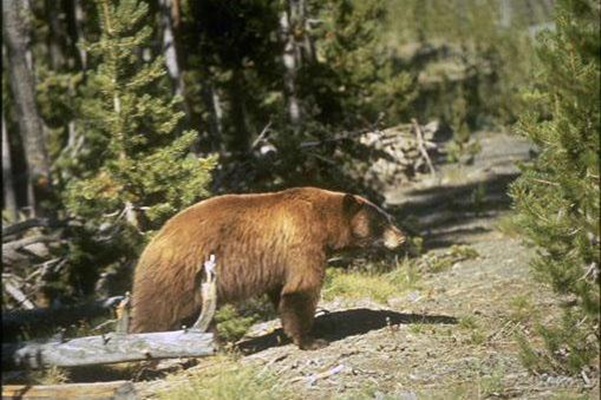
Oct. 3 (UPI) — The fight to remove grizzly bears from the endangered species list in Montana, Wyoming and Idaho is not over.
Days after a federal judge overturned the U.S. Fish and Wildlife Service’s decision to delist grizzly bears in those states, a Wyoming congresswoman proposed a bill to permanently delist the bears, a ranching group was looking to appeal the decision and the FWS said it is considering its next steps.
“We stand behind our scientific finding that the Greater Yellowstone Ecosystem grizzly bear is biologically recovered and no longer requires protection under the Endangered Species Act,” the FWS said in a statement.
U.S. District Judge Dana Christensen overturned the Service’s decision to delist the bears Sept. 24. He based the ruling, in part, on the FWS failure to consider the impact delisting the bears in the Yellowstone region would have on other, still not recovered, bear populations around the United States, according to the court order.
The decision has left ranchers in these states frustrated by the unchecked growth of the bear population.
“Grizzly bears have made an amazing recovery here,” said Wyoming Rep. Albert Sommers, who ranches in the eastern part of the state. “We’ve met every recovery goal required of us. The original recovery plan said that when we met those numbers the grizzly bear would be delisted.”
This is the second time the FWS has tried to remove Yellowstone-area bears’ threatened status. In 2007, the service announced the animal’s population had recovered and no longer needed federal protection. Conservation groups sued to stop the delisting, and a federal judge ruled in their favor, reinstating the bears’ protection in 2009.
It was the same story this year. The FWS delisted the bears in June 2017. Conservation groups and Native American tribes immediately sued, and the bears’ protection was restored.
Some in the region want to see the courts lose their ability to block delistings. The day after the judge’s ruling, U.S. Rep. Liz Cheney introduced a bill called the Grizzly Bear State Management Act that would remove the bears’ threatened status and bar further judicial intervention. The bill was referred to the House Committee on Natural Resources.
This worries conservation groups who believe that the Service is wrong in its assessment that the bear is recovered, and have no other recourse but the judicial system.
“There are only a couple grizzly bear populations that are viable in the United States,” said Wendy Keefover, the native carnivore protection manager at the Humane Society of the United States, one of the organizations that sued to stop the delisting. “In 50 years, we’ve not had one individual make it between them. There are just these tiny islands of grizzly bear populations left. They need far more protection, not less.”
Scientists estimate that before European settlers inhabited the United States there were around 50,000 grizzly bears roaming in the Rocky Mountains and beyond. Their range extended from central Mexico to Alaska.
But the settlers clashed terribly with grizzly bears. Humans and bears have similar diets, and were competing for many of the same foods. Grizzlies can also be extremely aggressive and dangerous.
The settlers wanted the bears eradicated, so the federal government implemented programs to do just that. Officials paid bounties for each bear killed. Thousands were shot, poisoned and trapped during the 19th century. Their numbers continued to fall in the 20th century, and by 1975 there were thought to be only a few hundred animals living in six disconnected groups in the lower-48.
Between 136 and 312 of those lived around Yellowstone, according to Christensen’s ruling.
By the late 20th century, popular opinion was swaying toward animal conservation, and in 1975 the bears were listed as a threatened species under the newly passed Endangered Species Act.
Their population has recovered some since then. Today, the FWS estimates there are between 1,400 and 1,700 wild grizzly bears in the lower-48. More than 700 of those are in the Yellowstone region.
Though it’s clear that other bear populations are still threatened, ranchers and others who live in the Yellowstone area say the number of bears there has exceeded the region’s capacity. Every year there are more bear encounters and ranchers are losing more livestock.
“If we’re just going to manage to eternally increase the number of grizzly bears, that’s going to be hard on ranchers,” said Jim Magagna, executive vice president of the Wyoming Stock Growers Association, one of the organizations looking to appeal Christensen’s decision.
As a lifelong rancher, Sommers remembers when he first encountered evidence that the grizzlies were making a comeback.
“It was 1993,” he told UPI, speaking from his ranch in Wyoming. “We were on a ride moving the cattle from one pasture to another, when we came across a calf that was obviously wounded. There was blood all over its back. All of us young pups, we had never seen anything like that before. But one of the older ranchers said, ‘That calf’s been bit by a bear.'”
Sommers and other ranchers in his cattle association were losing around 2 percent of their calves every summer. A decade later, that number grew to around 7 percent. Today, it’s closer to 15, he said. That’s around 200 calves a summer.
The problem is not just the killings, he said. The presence of the bears scares the animals, causing them to gain less weight and breed less.
“We understand this is a new reality we have to work within,” Sommers said. “But I don’t know how much more we can take. I think there needs to be some population control.”
Many ranchers say they believe the grizzly bears will eventually be delisted. They point to wolves as an example. Wolves and bears in North America have similar stories. They both were threats to humans and livestock, and were both nearly eradicated by the federal government during the 19th and early 20th centuries. Both were listed as endangered species in the 1970s, and their populations began to grow.
But unlike bears, wolves have been removed from the endangered species list in Idaho, Montana and Wyoming.
There were several lengthy court battles first. The FWS first tried to delist wolves in the Rocky Mountain area in 2008. Several court challenges successfully stopped the process, but they were eventually removed from the list in 2011. Idaho, Montana and Wyoming now allow wolves to be hunted.
“It’s just been a huge saga,” Keefover said. “There’s been a mountain of litigation. The bottom line is we must learn to coexist with these animals, or we’re going to lose them forever.”





